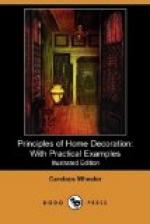[Illustration: DINING-ROOM IN “STAR ROCK” (COUNTRY HOUSE OF W.E. CONNOR, ESQ., ONTEORA)]
A library in ordinary family life has two parts to play. It is not only to hold books, but to make the family at home in a literary atmosphere. Such a room is apt to be a fascinating one by reason of this very variety of use and purpose, and because it is a centre for all the family treasures. Books, pictures, papers, photographs, bits of decorative needlework, all centre here, and all are on most orderly behaviour, like children at a company dinner. The colour of such a room may, and should, be much warmer and stronger than that of a parlour pure and simple, the very constancy and hardness of its use indicating tints of strength and resistance; but, keeping that in mind, the rules for general use of colour and harmony of tints will apply as well to a room used for a double purpose as for a single. Of course the furniture should be more solid and darker, as would be necessary for constant use, but the deepening of tones in general colour provides for that, and for the use of rugs of a different character. In a room of this kind perhaps the best possible effect is produced by the use of some textile as a wall-covering, as in that case the same material with a contrasted colour in the lining can be used for curtains, and to some extent in the furniture. This use of one material has not only an effect of richness which is due to the library of the house, but it softens and brings together all the heterogeneous things which different members of a large family are apt to require in a sitting-room.
To those who prefer to work out and adapt their own surroundings, it is well to illustrate the advice given for colour in different exposures by selecting particular rooms, with their various relations to light, use, and circumstances, and seeing how colour-principles can be applied to them.
We may choose a reception-hall, in either a city or country house, since the treatment would in both cases be guided by the same rules. If in a city house, it may be on the shady or the sunny side of the street, and this at once would differentiate, perhaps the colour, and certainly the depth of colour to be used. If it is the hall of a country house the difference between north or south light will not be as great, since a room opening on the north in a house standing alone, in unobstructed space, would have an effect of coldness, but not necessarily of shadow or darkness. The first condition, then, of coldness of light would have to be considered in both cases, but less positively in the country, than in the city house. If the room is actually dark, a warm or orange tone of yellow will both modify and lighten it.
Gold-coloured or yellow canvas with oak mouldings lighten and warm the walls; and rugs with a preponderance of white and yellow transform a dark hall into a light and cheerful one. It must be remembered that few dark colours can assert themselves in the absolute shadow of a north light. Green and blue become black. Gold, orange, and red alone have sufficient power to hold their own, and make us conscious of them in darkness.




